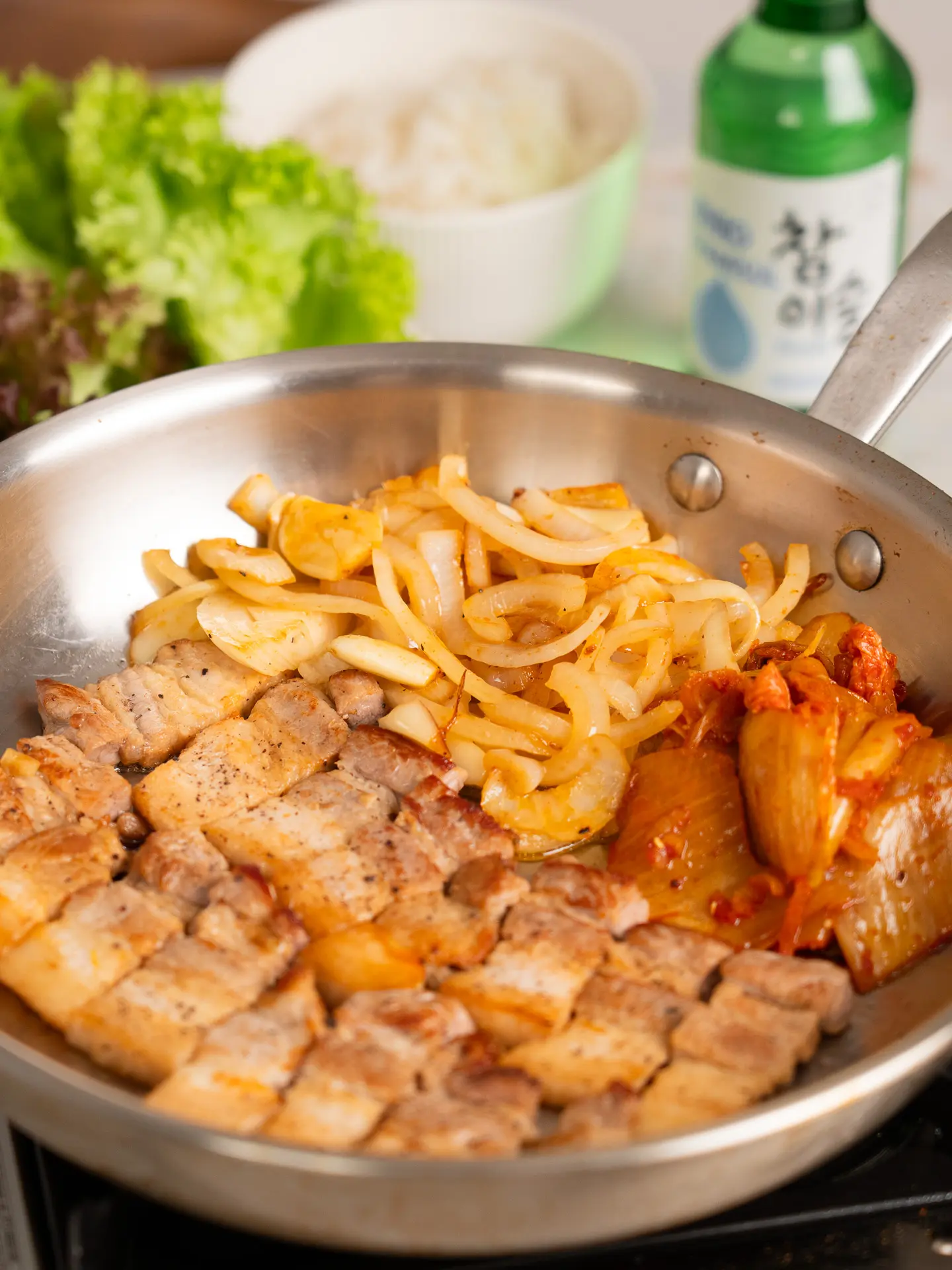Let’s make Korean BBQ at home!
For Koreans, Korean BBQ can be a quick 15-minute meal for lazy days when you don’t feel like cooking. It’s a dish enjoyed at gatherings with friends and family as well as at home alone. The home version is much simpler than what you’ll find at a Korean BBQ restaurant, with fewer side dishes, making it the perfect lazy dinner option.
Today, we’ll go over the side dishes and dipping sauces to pair with your Korean BBQ – the simplest and easiest versions, but still delicious!
Table of Contents
What is Korean BBQ?
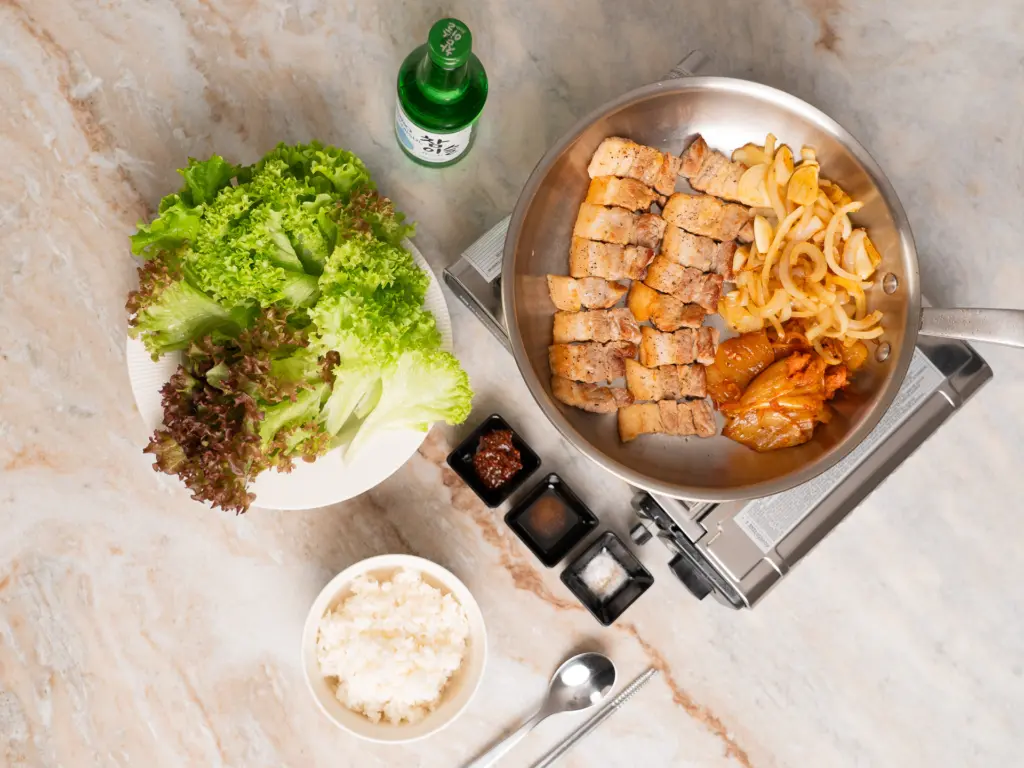
Korean BBQ is a unique Korean food culture where meat is grilled directly at the table. The most popular choice is samgyeopsal (pork belly), followed by moksal (pork neck). On special occasions, premium cuts such as hanwoo beef short ribs (galbi) are also enjoyed.
The charm of Korean BBQ lies not only in the fresh meat, but also in the harmony of various banchan (side dishes), fresh vegetables for ssam, and dipping sauces. Grilled meat is often wrapped in leafy greens such as lettuce or perilla leaves, with side dishes such as garlic or kimchi to enhance the flavors. The go-to sauce is ssamjang, a savory blend of soybean paste (doenjang) and chili paste (gochujang) that can be adjusted to taste.
Types of Korean BBQ
Korean BBQ typically features beef and pork as the main meats, along with marinated BBQ options. While chicken is often grilled at Korean BBQ restaurants abroad, it’s not as common in Korea. When chicken is served, it’s usually in the form of dakgalbi, which is marinated in a spicy sauce.
- Beef
Popular cuts of beef for Korean BBQ include galbi (short rib), kkotdeungsim (ribeye), chaekkeutsal (sirloin), ansim (tenderloin), and chadolbaegi (brisket). Koreans prefer cuts with tender, rich marbling, which tend to be more expensive. Hanwoo beef(Korean beef), known for its premium quality, is particularly expensive and is often reserved for special occasions at restaurants.
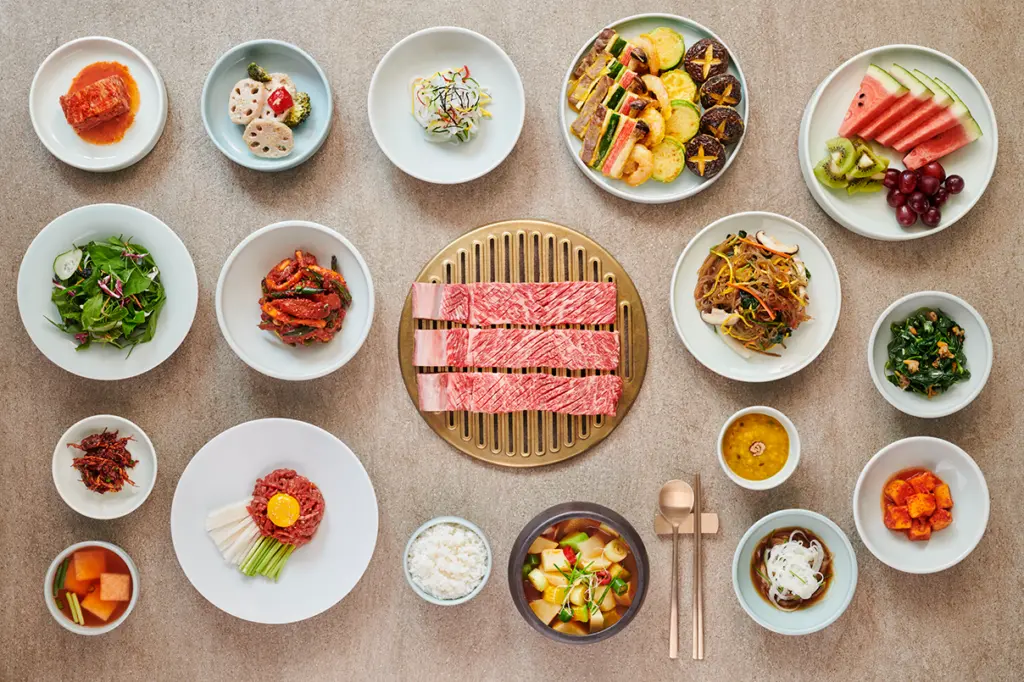
- Pork
For many Koreans, pork BBQ is the essence of the Korean BBQ experience. The most popular cut is samgyeopsal (pork belly), followed by moksal (pork neck). These cuts are often enjoyed simply with salt or wrapped in fresh lettuce with dipping sauces. - Marinated BBQ
Marinated BBQ dishes include pork galbi(ribs) and beef galbi(ribs), which are soaked in a sweet and savory soy-based marinade. The marinade often includes Korean pear, which tenderizes the meat and adds a natural sweetness that creates a melt-in-your-mouth experience.
This is a gochujang BBQ recipe that blends Korean BBQ with American BBQ platter style. It’s a dish that brings an exotic flavor to the table and delights everyone on special occasions.
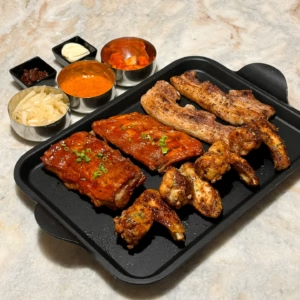
What Makes Korean BBQ Different?
Korean BBQ typically involves sitting together in a restaurant, where guests grill and cook the meat on a built-in grill or portable burner at the table, cooking and cutting the meat themselves. At home, however, people usually grill the meat in the kitchen and bring it to the table to eat. With the rise of single-person households, Korean BBQ is no longer just a communal meal and has become a popular option for solo dining.
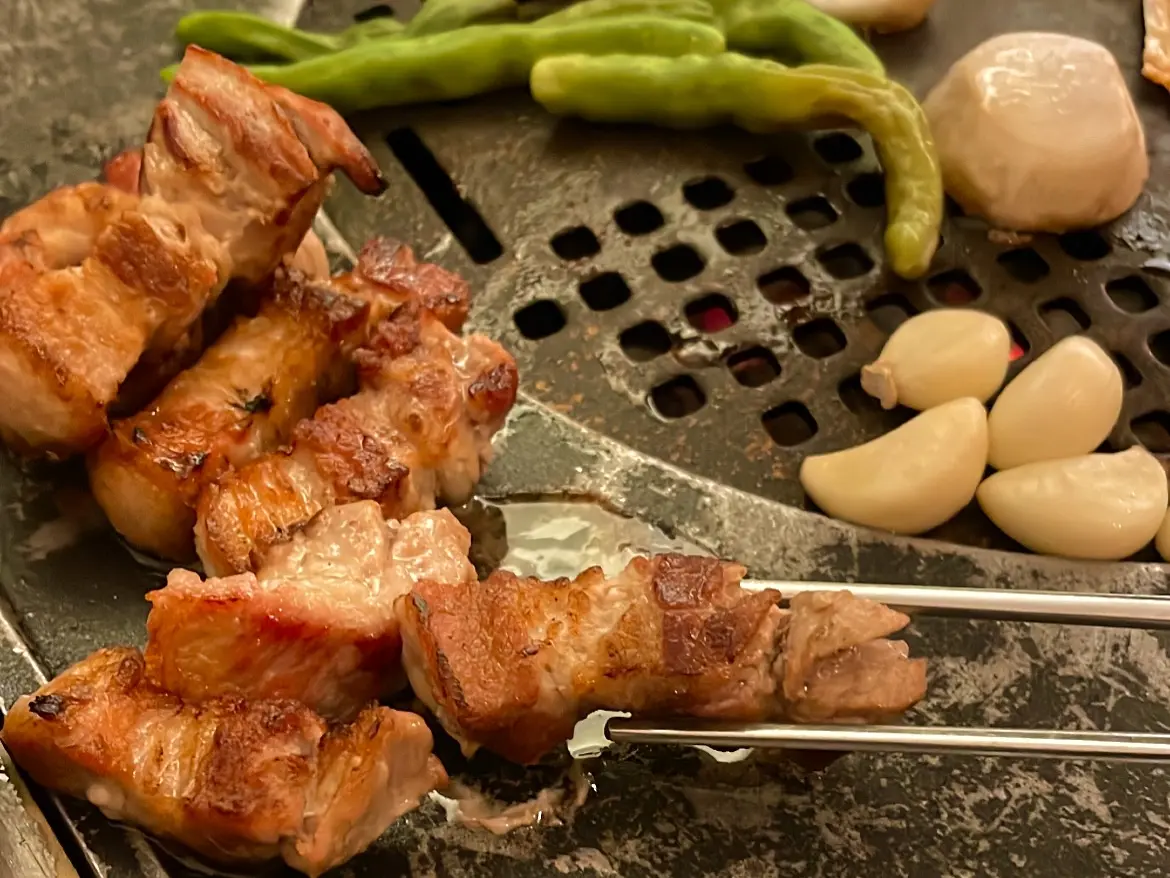
Variety of Side Dishes
Korean BBQ is served with a variety of side dishes, such as kimchi and green onion salad. These side dishes can be replenished at no additional cost.
Ssam (Korean Wraps) 쌈
Ssam is grilled meat wrapped in lettuce or perilla leaves with side dishes such as kimchi, rice and sauces such as ssamjang. It must be eaten in one bite. Only by eating everything in one bite can you fully experience the harmony of flavors that is the essence of ssam.
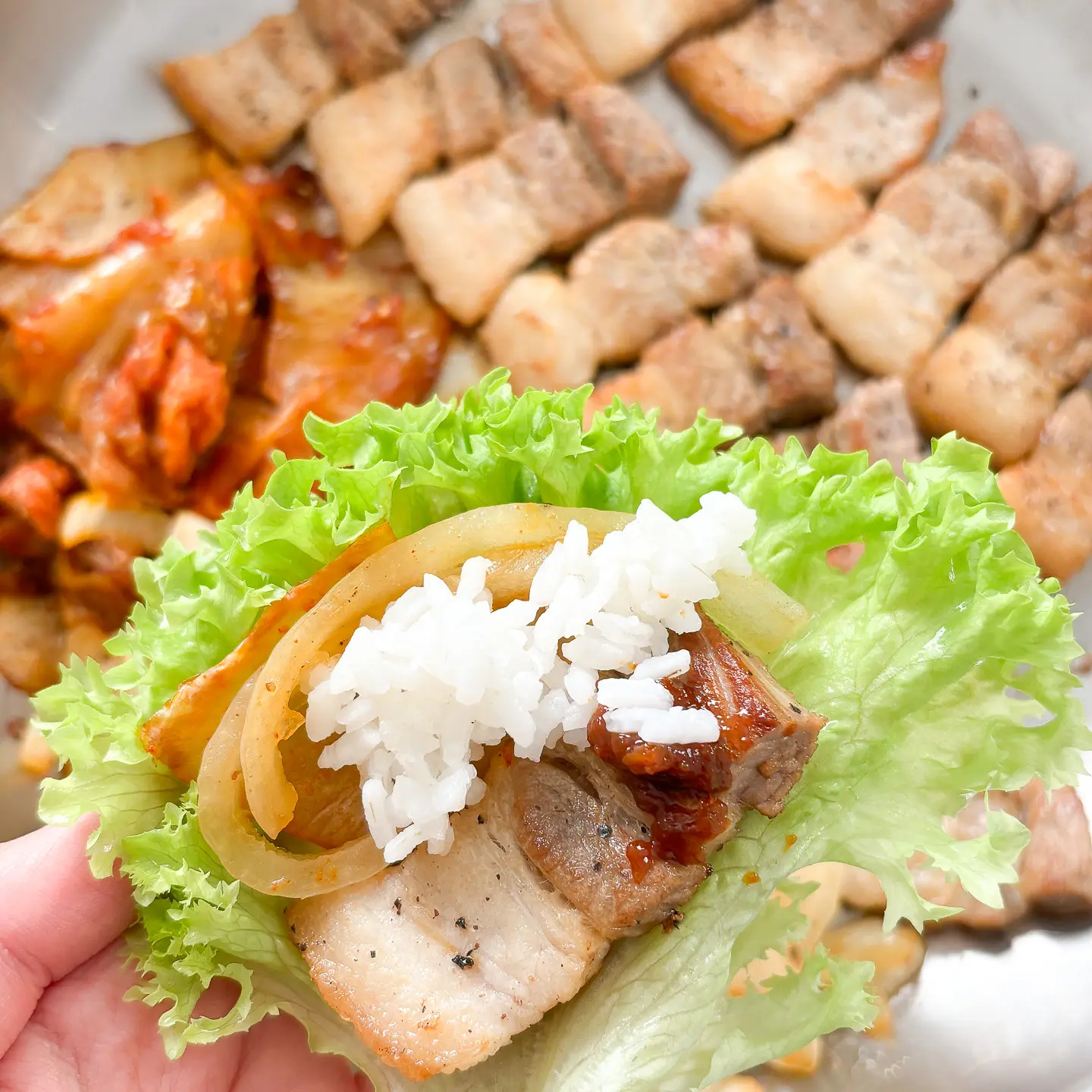
Various Dipping Sauces
There are many dipping sauces for Korean BBQ. Common options include ssamjang, sesame oil sauce, and salt and pepper sauce. Some restaurants also offer wasabi. Today, I’ll show you how to make a variety of dipping sauces.
“Dessert” That Feels Like a Main Dish
After enjoying Korean BBQ, people often have a “dessert” that feels more like a main dish. At Korean BBQ restaurants, common “desserts” include fried rice, doenjang-jjigae (soybean paste stew) with rice, or naengmyeon (cold noodles). I’ll explain how to make fried rice in detail below.
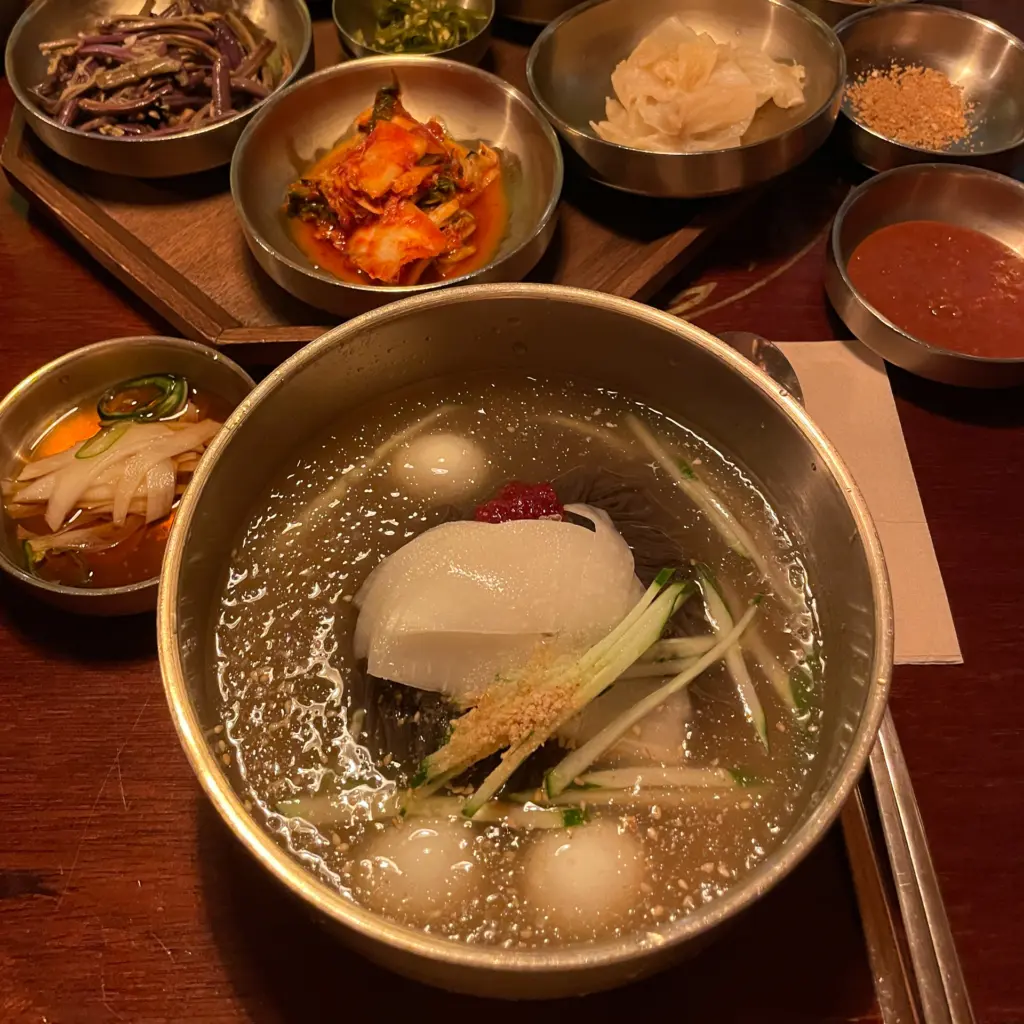
How to Cook Korean BBQ Without a Grill?
Many of my European friends have asked this question. You don’t need a grill. Many Koreans don’t use a grill when they cook Korean BBQ at home. So what do they use? A lot of Koreans cook Korean BBQ using a frying pan.
How to Call Korean BBQ in Korean?
In Korea, there is no specific term for “Korean BBQ”. Literally translated, it would be “gogi gui” (grilled meat), but no one really uses that term – it feels like something you’d find in Google Translate. Instead, we usually refer to the specific cuts of meat. For example, we say “Samgyeopsal for two, please” or “Let’s go eat Korean beef.”
What Is the Sauce for Korean BBQ?
The most common sauces for Korean BBQ are ssamjang, gochujang, salt & pepper, and sesame oil sauce.
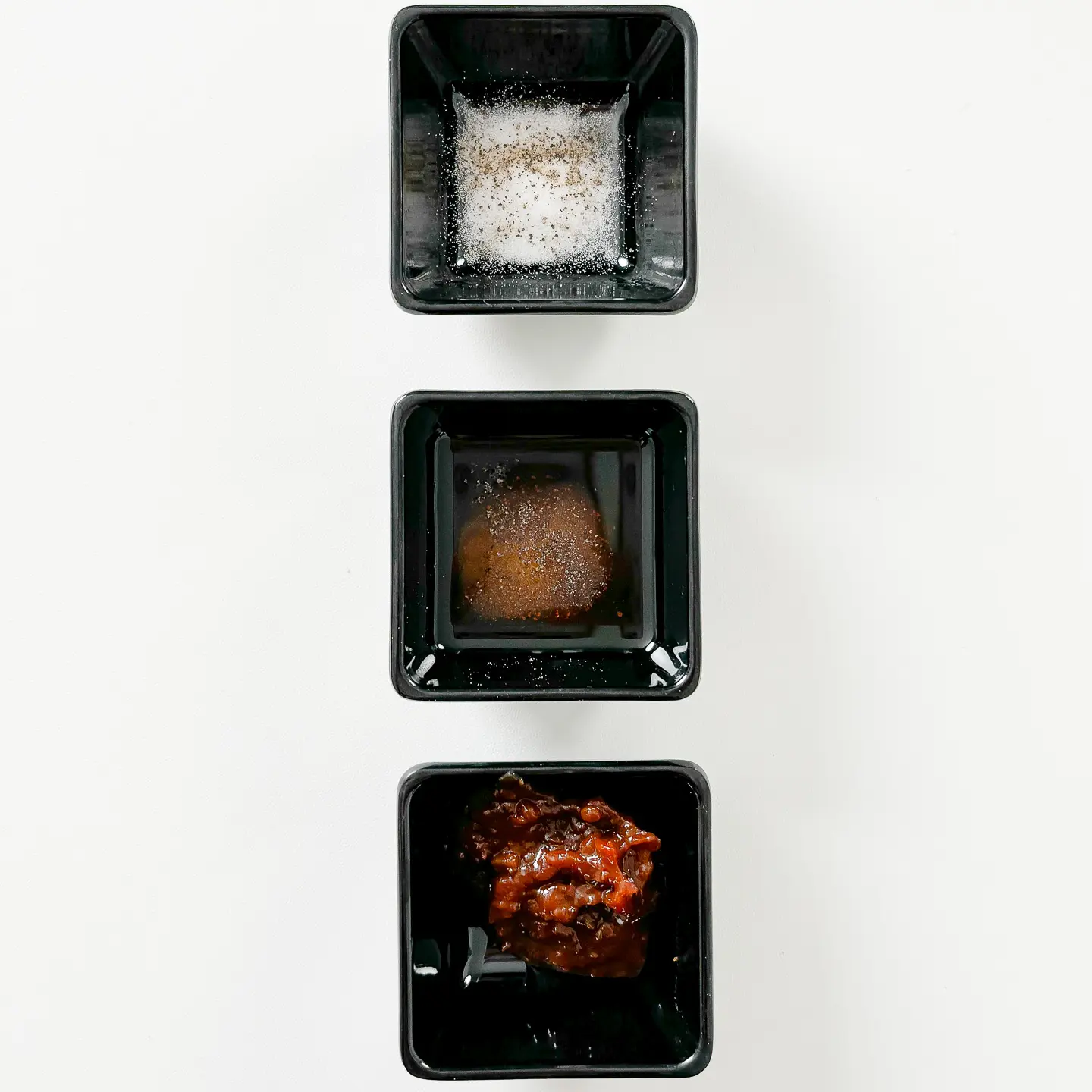
- If you want to taste the true flavor of the meat, dip it in salt & pepper.
- If you like a nutty flavor, dip it in sesame oil sauce.
- For a more spicy flavor, dip the meat in ssamjang or gochujang.
- Best recommendation: Dip the meat in sesame oil sauce first, then add ssamjang or gochujang. The combination of nutty flavor and seasoning is truly delicious.
In today’s recipe, I’ll show you how to make sesame oil sauce and salt and pepper sauce.
What To Drink With Korean BBQ?
For Koreans, Korean BBQ is often a dish enjoyed in a group setting, whether at a company dinner or a gathering with friends. It’s common to pair it with alcohol to enhance the lively atmosphere, and usually soju or a mix of soju and beer (known as “so-maek”) is served.
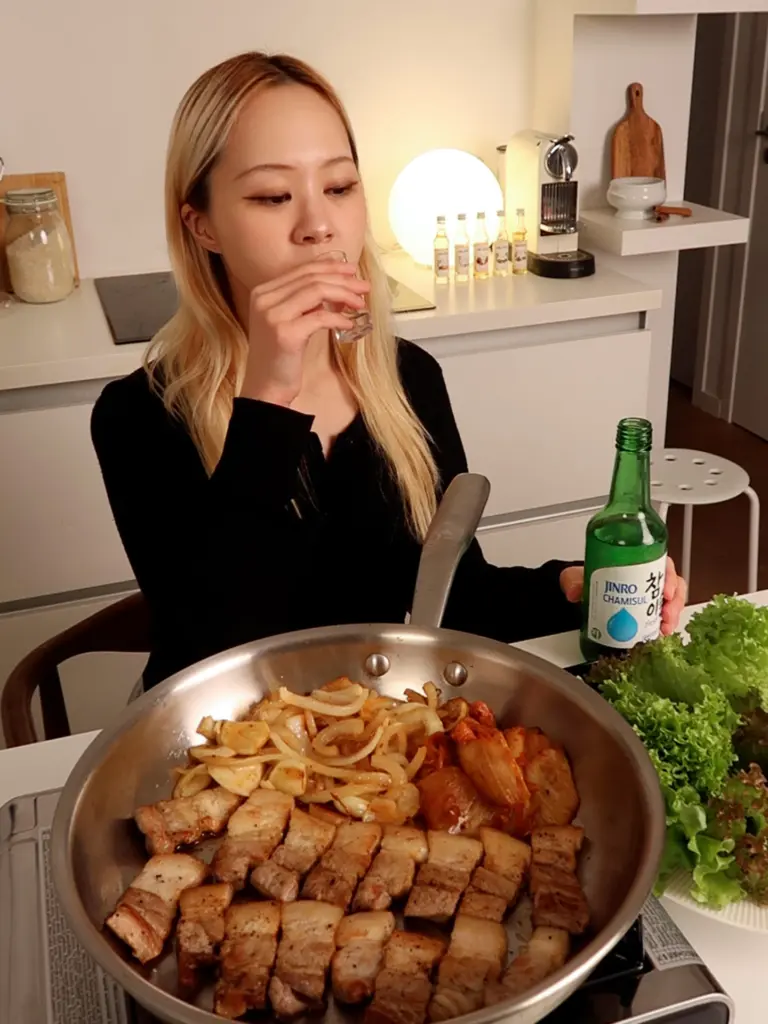
Soju is great for cutting through the greasiness of BBQ, making it a perfect match, especially with samgyeopsal (pork belly). For something smoother and more drinkable, try so-maek, a blend of soju and beer. The combination of so-maek and samgyeopsal is a popular pairing among Koreans.
For children or those who don’t drink, cola is a popular choice. Some children, imitating adults, mix sprite and cola to make a drink that looks like so-maek and call it ssakol(cider and cola).
What Sides Go With Korean Barbecue?
Interestingly, if you search this question on Google, tteokbokki (spicy rice cakes) comes up. I’ve often seen Korean BBQ restaurants overseas serving tteokbokki and Korean fried chicken along with their BBQ dishes. However, in Korea, Korean BBQ restaurants don’t usually sell fried chicken or tteokbokki. So what do Koreans actually eat with their Korean BBQ?
Here are some of the traditional sides that accompany Korean BBQ:
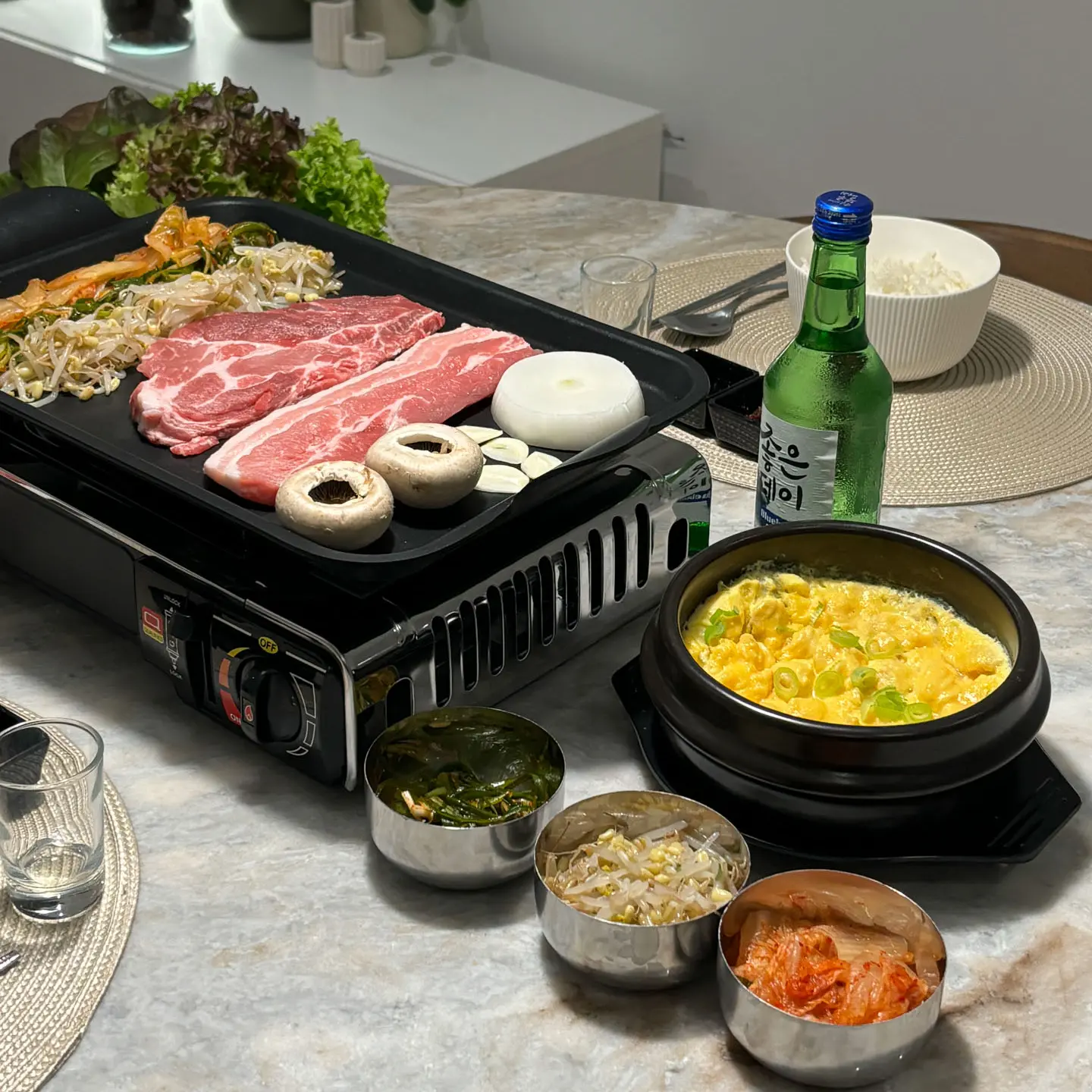
- Garlic, Onions and Mushrooms For Grill
Koreans often grill garlic, onions, and mushrooms with their BBQ meat. These additions enhance the flavor of the barbecued meat and make for a delicious combination.
- Lettuce and Perilla Leaf Wraps (Ssam)
These fresh leaves are used to wrap grilled meats with other ingredients. They’re an essential part of the BBQ experience and provide a refreshing balance to the richness of the meat.
- Kimchi
Kimchi can be eaten raw, but it’s often stir-fried in the oil from the grilled meat, which enhances its umami and adds depth to the flavor.
- Green Onion Salad (Pa Muchim, Pajeori)
Thinly sliced green onions are seasoned with chili powder, soy sauce, vinegar, and sugar to create a spicy and slightly sweet dish. Pa muchim helps balance the fatty richness of the BBQ, especially when paired with samgyeopsal (pork belly).
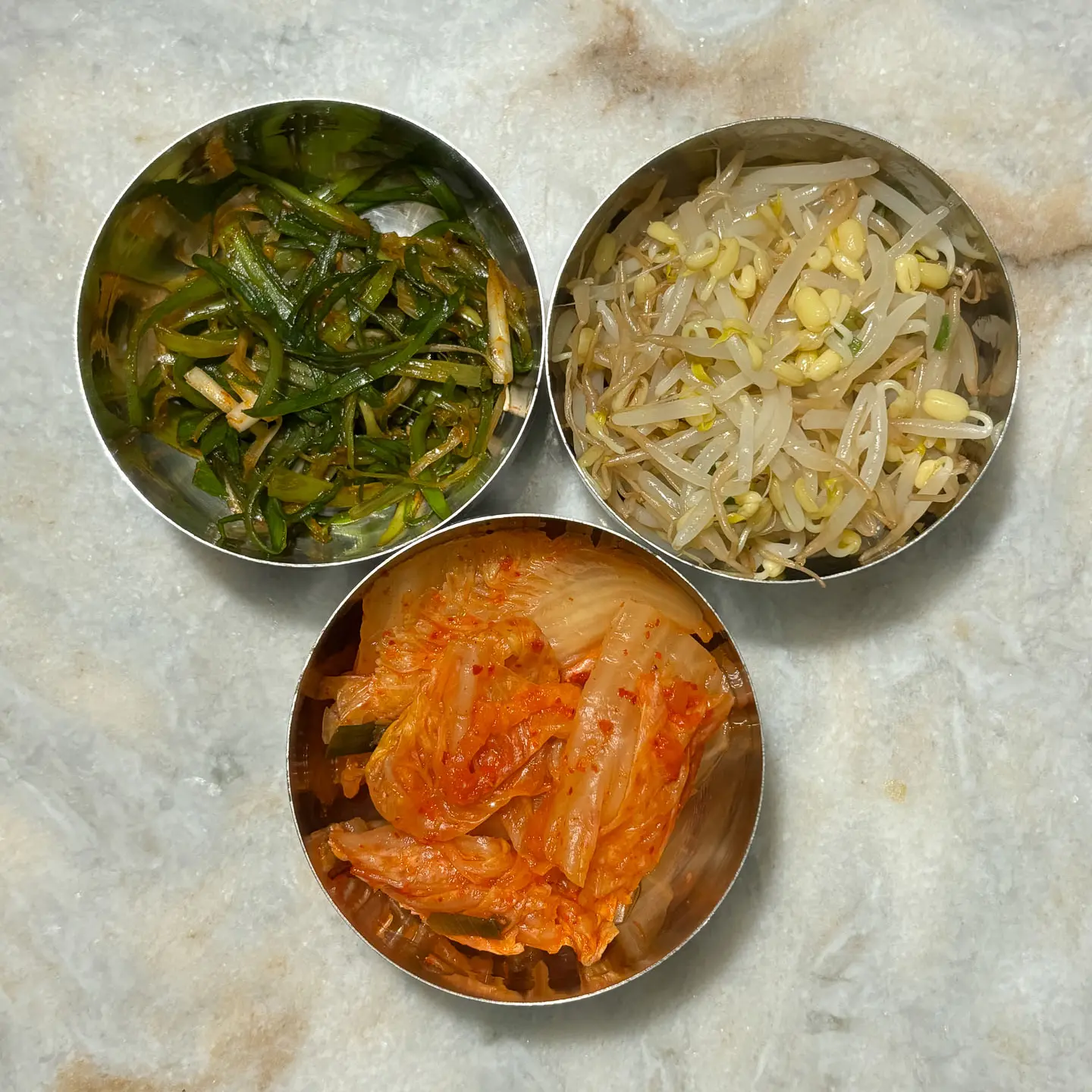
- Spiced bean sprouts (Kongnamul Muchim)
This is one of the essential side dishes for Korean BBQ, with a savory, slightly salty flavor from sesame oil. In Korea, it’s usually mixed with chili powder, but in other countries it may be served without.
- Pickled Radish (Ssam mu)
In Korea, pickled radish is often wrapped around the meat. It provides a cool, crunchy contrast to the warm, savory BBQ.
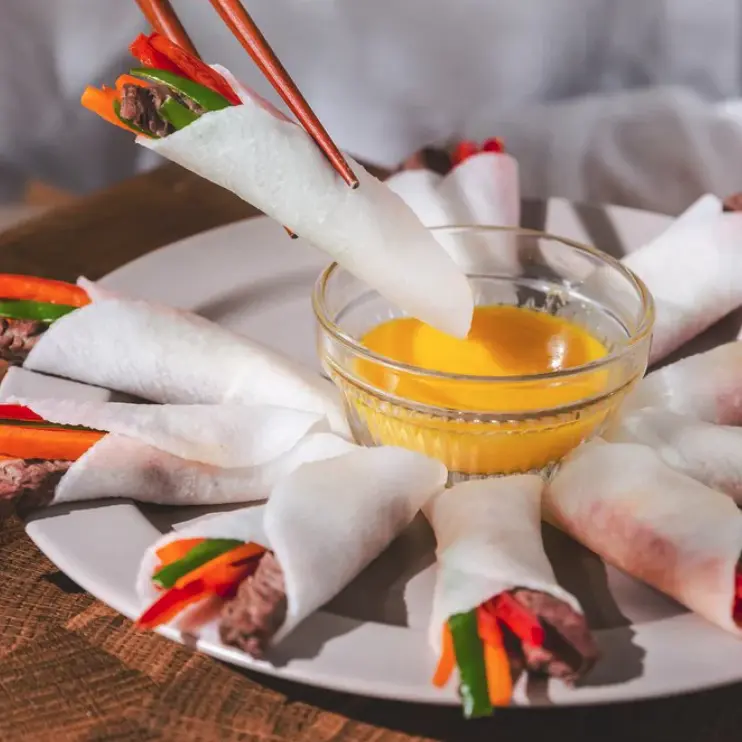
Dipping Sauces
Typical dipping sauces include salt, ssamjang (a fermented blend of soybean and chili paste), gochujang (Korean chili paste), and sesame oil. These condiments add layers of flavor to every bite.
- Steamed eggs (Gyeranjjim)
Steamed eggs in a hot pot (ttukbaegi) is a warm, comforting dish often served as a side dish with Korean BBQ. It’s easy to make and often served at Korean BBQ restaurants.
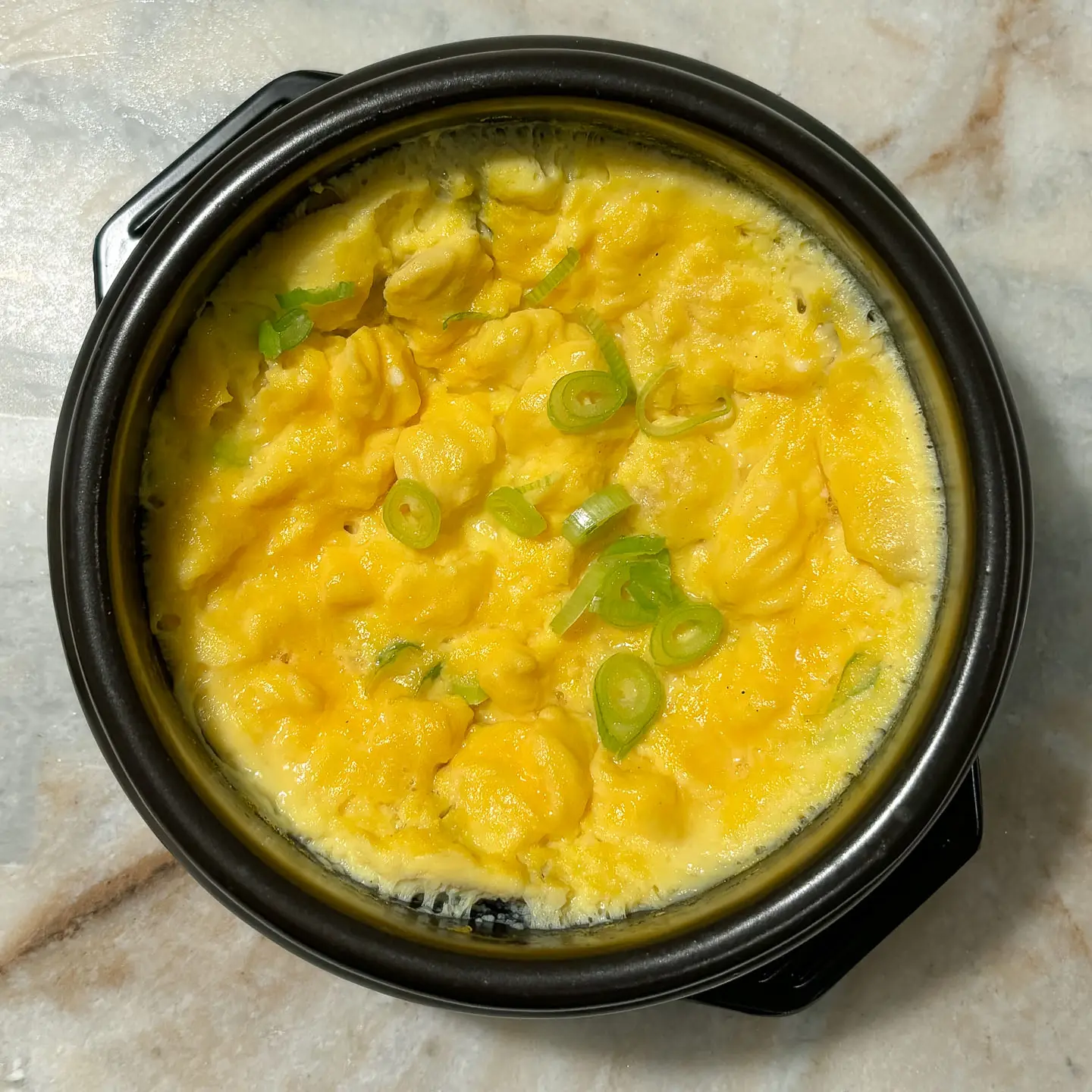
- Raw garlic and chili peppers
These raw ingredients are perfect for adding a sharp, pungent kick to the wraps that cuts through the richness of the meat.
- Doenjang jjigae (soybean paste stew) and rice
After enjoying BBQ meat, a bite of doenjang jjigae (soybean paste stew) feels like the perfect way to complete the meal. The hearty stew and rice are a satisfying combination.
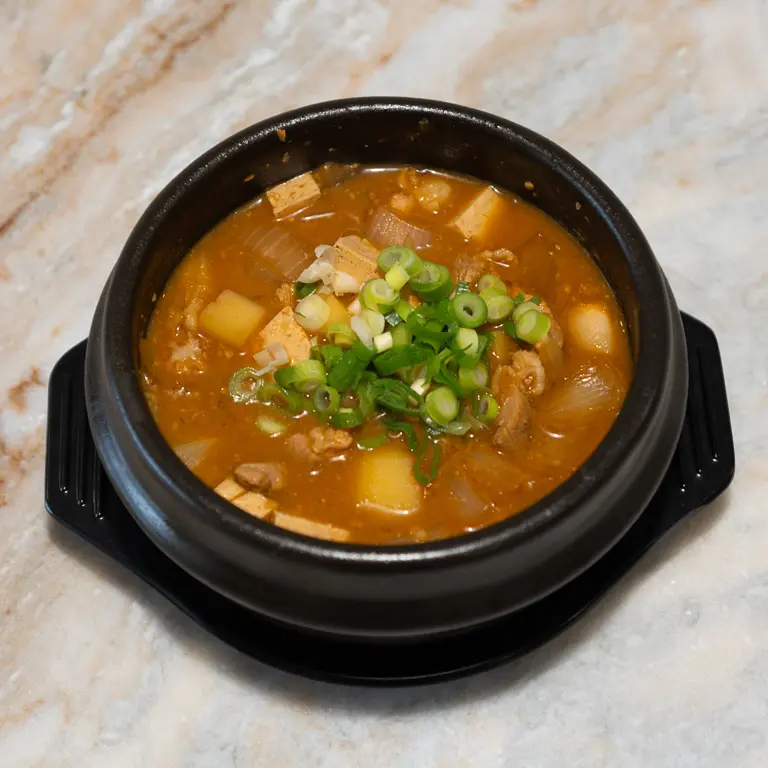
- Cold Noodles (Naengmyeon)
Korean BBQ and cold noodles are a popular pairing. Especially in the summer, Koreans often enjoy a refreshing bowl of naengmyeon to balance the richness of grilled meats.
These side dishes, along with BBQ, create the perfect Korean meal, balancing flavors and textures to make every bite more enjoyable.
Korean Dessert
In Korean restaurants, after you finish your BBQ, the staff will usually ask, “What would you like for dessert?” However, the dessert they are referring to is not what you might think, like coffee or cake. Instead, it’s something more like a side dish, such as cold noodles (naengmyeon) or a bowl of rice with doenjang jjigae (soybean paste stew).
But if you have leftover meat, the proper “dessert” to order is fried rice (bokkeumbap). In this dish, the leftover meat, kimchi, spices, and rice are all fried together. This is a special treat that you can enjoy at Korean BBQ restaurants.
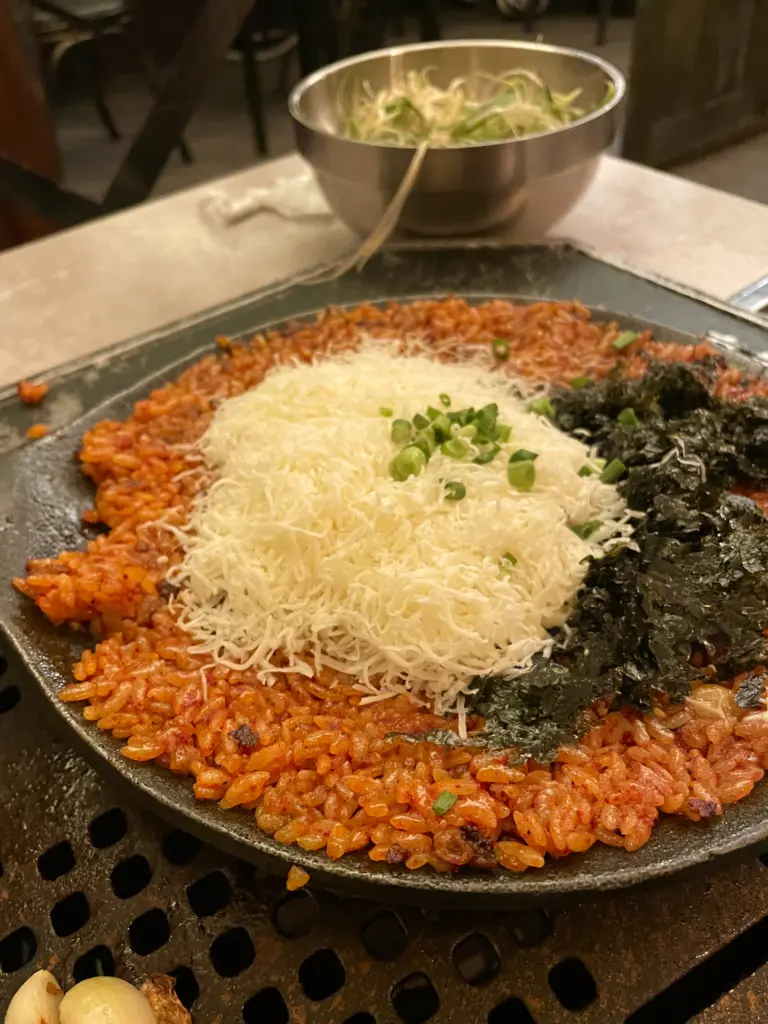
Koreans actually refer to this fried rice as Korean dessert (K-dessert). It’s something that many foreigners may not know about, which is really a shame! I hope everyone reading this gets a chance to try it.
And no, you don’t have to wait for a restaurant to enjoy it! You can easily make it at home by frying up some leftover meat, kimchi, rice, ssamjang (fermented soybean paste), and sesame oil. It’s so delicious it will make your eyes widen with delight!
Korean BBQ at Home
Home-style Korean BBQ is very different from the restaurant experience.
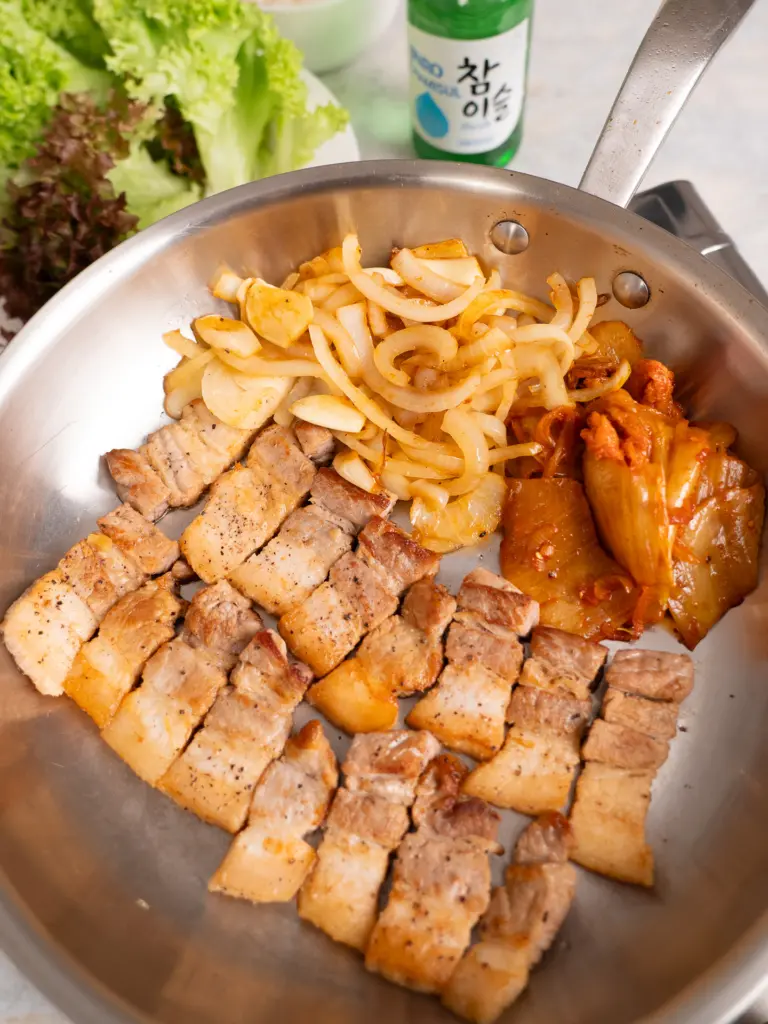
A pan
Restaurants often use grills and charcoal, but at home it’s usually cooked on a gas stove with a frying pan. A thicker pan is better.
Cooking in the kitchen
In a restaurant, BBQ is usually done at the table, where diners cook their own meat. But in a Korean household, the meat is usually cooked in the kitchen and brought to the table when it is done.
Simplified Side Dishes
While restaurants serve a variety of side dishes along with BBQ, many of these side dishes are simplified at home. In fact, I’ve noticed that Korean BBQ restaurants in Europe or the U.S. often serve far more side dishes than in Korea, as foreigners may expect a more elaborate spread that reflects a traditional Korean meal.

However, when eating BBQ at home, it’s quite common to simply have meat, kimchi, and rice. For a family meal, doenjang jjigae (soybean paste stew) is often made and the BBQ meat is wrapped in lettuce leaves (ssam). If you want a more complete meal, you can add side dishes such as pa-jeol-i (pickled scallions) or kongnamul-muchim (pickled bean sprouts). If someone is really in the mood for a restaurant-style meal at home, they might even prepare steamed eggs or pickled onions.
Meat
Koreans prefer cuts of meat with tender fat, and the most common choice is samgyeopsal (pork belly). If they want more variety, they can get mok-sal (pork neck).
Below is a recipe for kimchi jjim made with pork belly, where the pork fat and kimchi blend beautifully to make a dish that could easily fill two servings of rice.
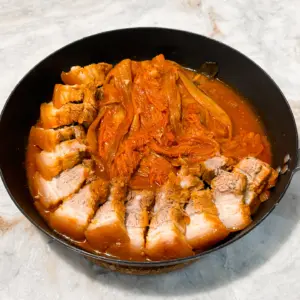
Sauces
Restaurants serve a variety of dipping sauces, but at home it’s common to simply dip the meat in ssamjang (fermented soybean paste). For a more flavorful experience, people may make additional sauces such as salt and pepper or sesame oil sauce.
Dessert
While restaurants may serve fried rice, doenjang jjigae with rice, or even naengmyeon (cold noodles) as a dessert, at home, doenjang jjigae and rice are usually eaten as part of the main meal, and naengmyeon is not commonly made because it’s more complicated. Fried rice, on the other hand, is a delicious way to finish the meal-but it’s only made when there’s leftover meat, which is rarely the case with home BBQs.
Get Ingredients Here
Kitchen Scissors
It’s essential when cooking Korean BBQ.
- Shop in EU: https://amzn.to/41lXZ61 (NL), https://amzn.to/41E7b6W (DE)
Ssamjang (Dipping Sauce)
- Shop in EU: https://amzn.to/43EJdKz (DE), https://amzn.to/3Dkfn2Z (NL)
Kimchi
- Shop in the US: https://amzn.to/3XqZiQ0
- Shop in EU: Shop in EU: https://amzn.to/4hNwgl4 (Germany), https://amzn.to/4hNwqsG (UK)
Sesame seeds (on stir fried kimchi)
- Shop in the US: https://amzn.to/3D85aXg
- Shop in EU: https://amzn.to/3EQVBwt (DE), https://amzn.to/3D7C6iD (NL)
Sesame oil
- Shop in the US: https://amzn.to/3QCZIyE
- Shop in EU: https://amzn.to/43fg5cn (DE), https://amzn.to/4bdP8Ys (NL)
Rice
- Shop in the US: https://amzn.to/4bdcfCH
- Shop in EU: https://amzn.to/41xxThP (NL), https://amzn.to/4kgVgmQ (DE)
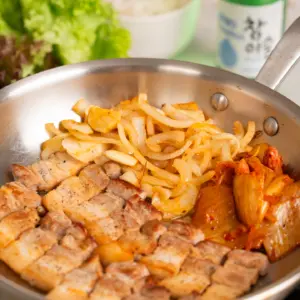
Korean BBQ at Home
Equipment
- 1 thick frying pan (no grill needed)
- 1 kitchen scissors
- 1 Tongs
- 1 Knife and cutting board
Ingredients
- 400 g pork belly (with fat)
- 2 pinches salt (marinade the meat)
- 6 twists black pepper (marinade the meat)
- 2 tbsp cooking oil
- 200 g kimchi
- 100 g lettuce
- 1 bulb whole garlic
- 1/2 onion
- 2 bowls rice
- 1 tbsp ssamjang (Korean BBQ dipping sauce)
Sesame Oil Sauce
- 2 tbsp sesame oil
- 0.5 tbsp salt
- 1 pinch black pepper
Salt & Pepper Dip
- 1 tsp salt
- 1 pinch black pepper
Instructions
Prep the Meat
- Pat the pork belly dry with a paper towel.
- Season with salt and black pepper, then let it sit for 10-15minutes.
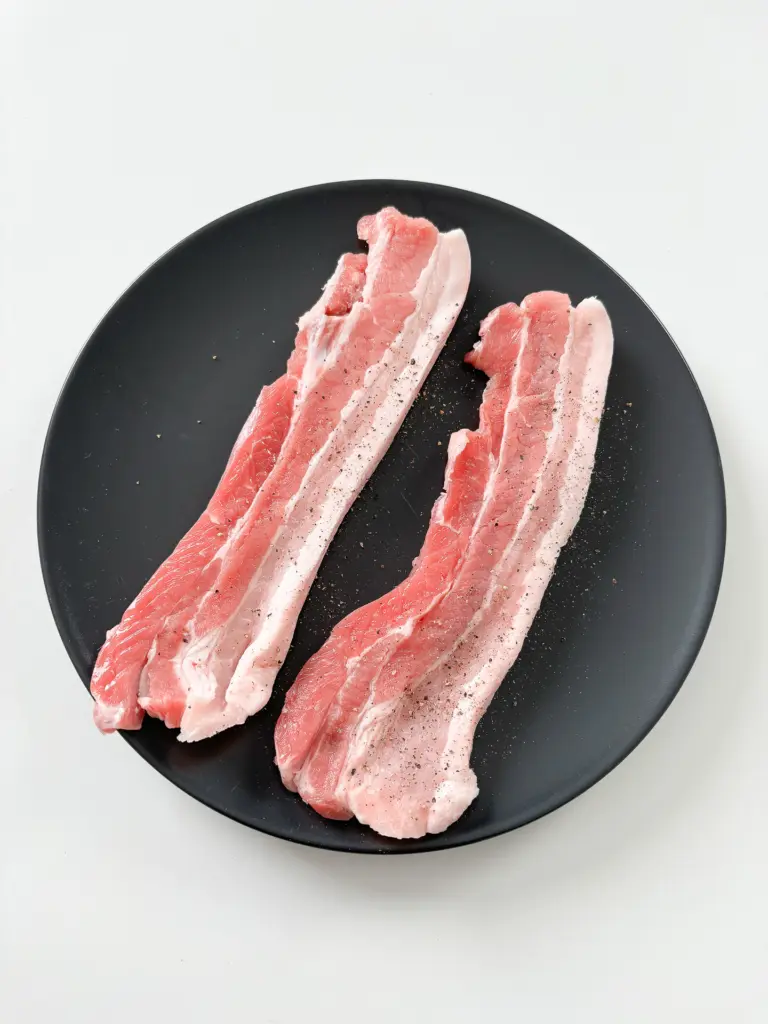
Prepare the Sauces
- Salt & Pepper Dip: 1 tsp salt, a pinch of black pepper.
- Ssamjang: 1 tbsp ssamjang (Korean dipping sauce).
- Sesame Oil Sauce: 2 tbsp sesame oil, 0.5 tbsp salt, a pinch of black pepper.
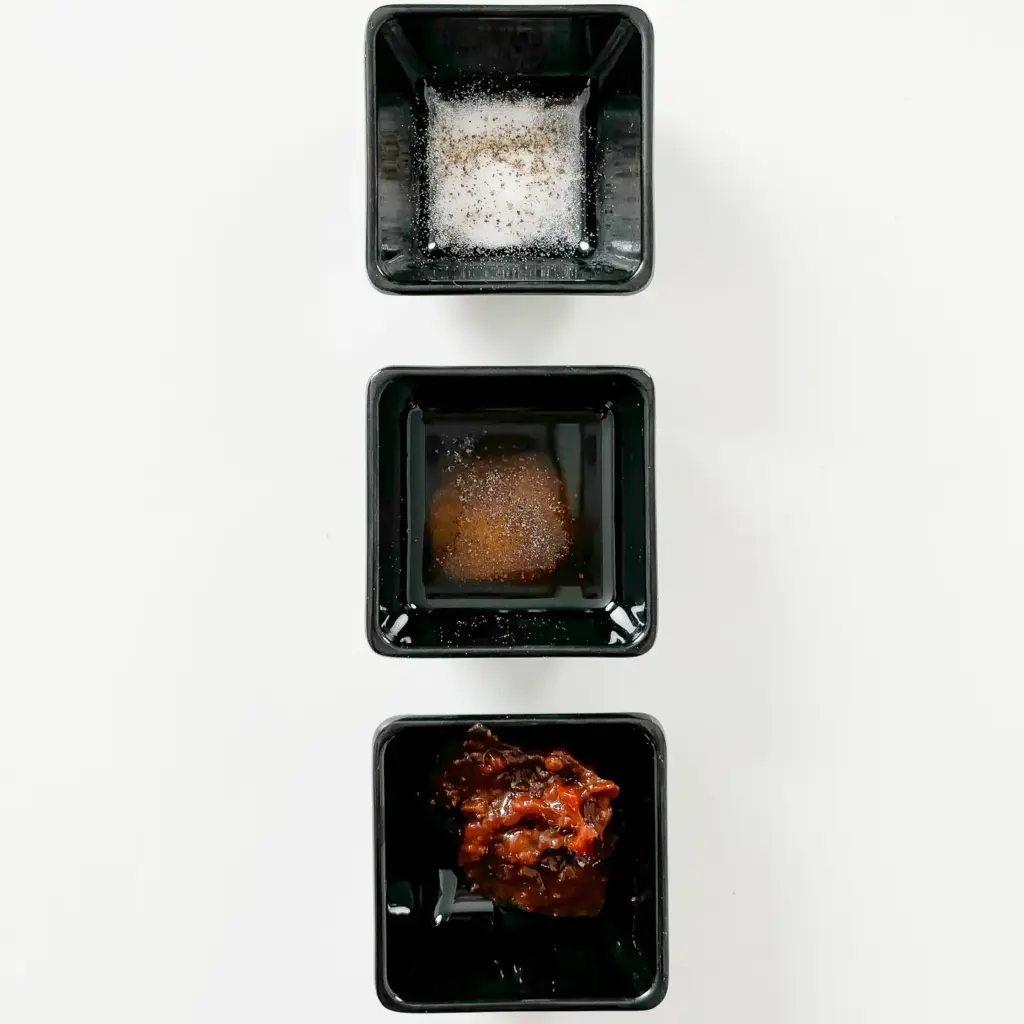
Vegetable Prep
- Wash the lettuce thoroughly.
- Peel a whole bulb of garlic and remove the stem.
- Slice half an onion into 0.5 cm strips.
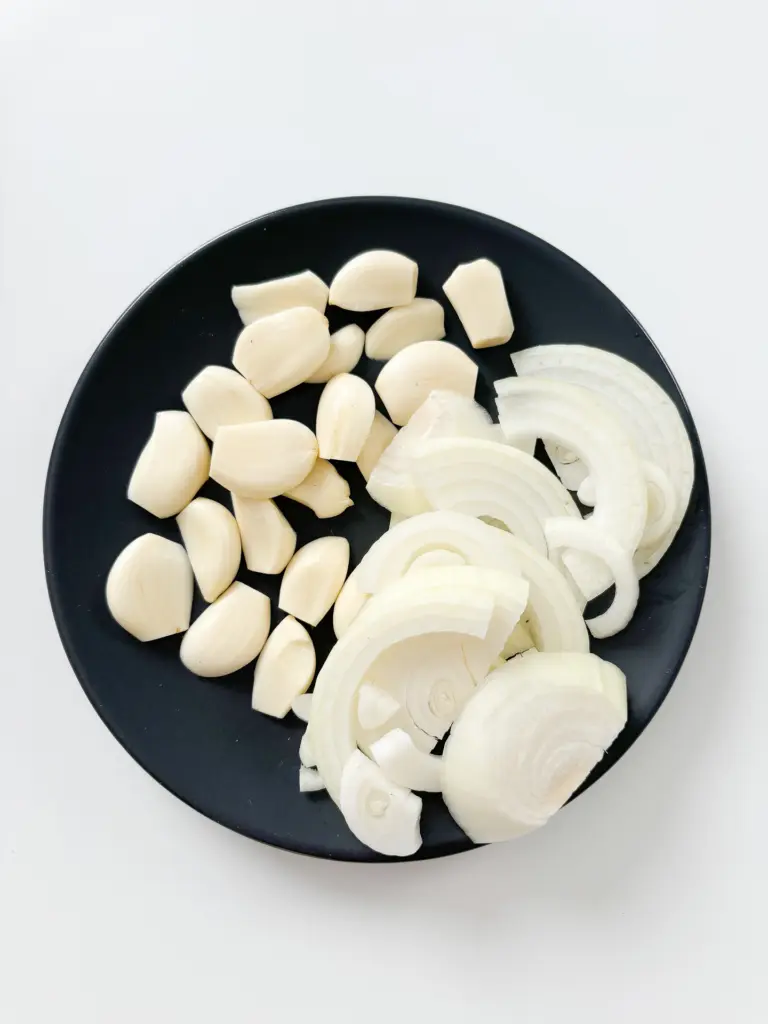
Heat the Pan
- Preheat a thick frying pan on high heat for 1–2 minutes.
Add Oil
- Pour 2 tablespoons of cooking oil into the pan. (Adding oil ensures the meat cooks evenly and gets a crispy exterior.)
Cook the Pork Belly
- Set the heat to high and place the pork belly on the pan.
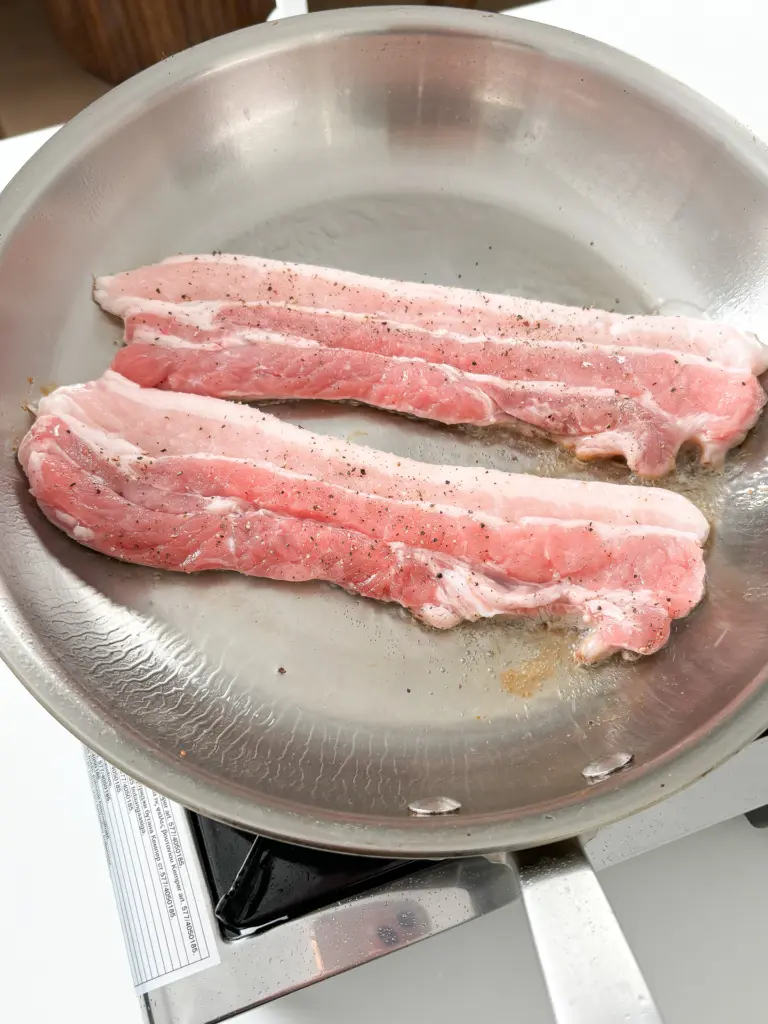
- Once the pork belly starts releasing fat, gently move the meat around. This helps cook it evenly.
- When the pink color on the meat is almost gone, flip it over.
- Reduce the heat to medium.
Cook the Garlic
- When the pork releases its fat, add the garlic.
- Fry the garlic in the pork fat until golden.
Add the Onions
- Cook the onion slices until they become soft and slightly caramelized.
Flip and Cut the Pork
- When the pork is about 70% cooked, cut it into bite-sized pieces with kitchen scissors and finish cooking.
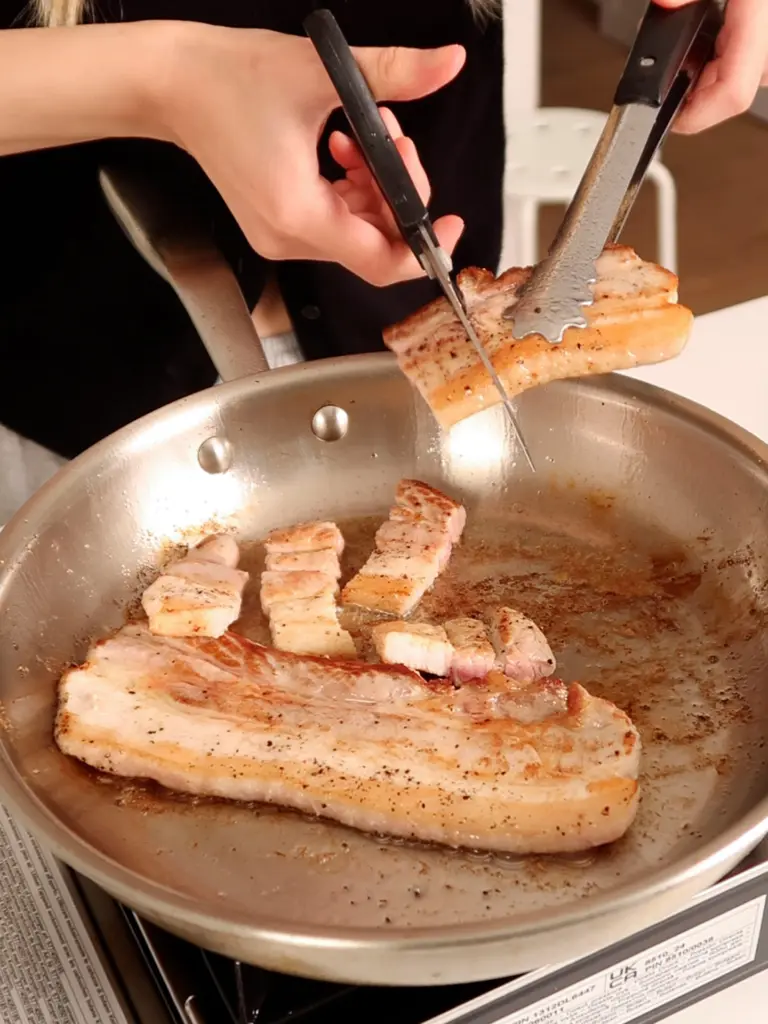
- Keep turning the meat often to avoid burning and ensure even cooking.
Cook the Kimchi
- Remove the meat from the pan.
- Add the kimchi to the remaining pork fat in the pan and sauté on medium heat. (This step enhances the kimchi's flavor—be careful not to burn it!)
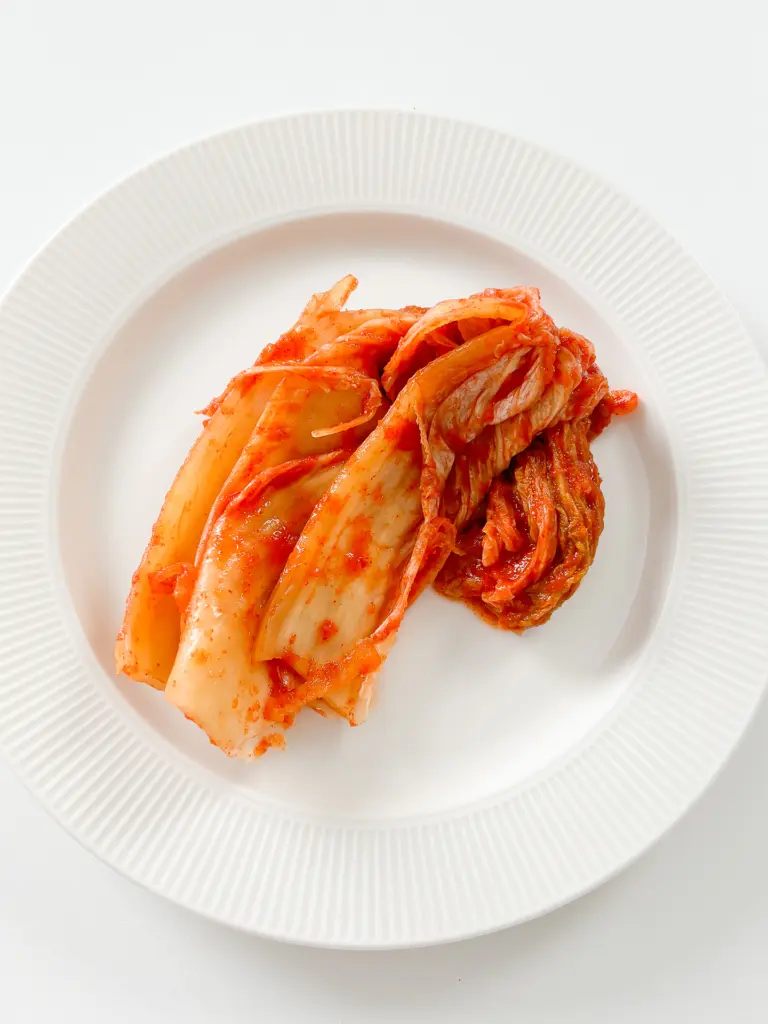
Let’s make Ssam!
- Pick a lettuce leaf.
- Dip the pork belly in the sesame oil sauce, then add it to the wrap.
- Top with kimchi, garlic, onions, a dollop of ssamjang and rice.

Wrap(Ssam) and Eat
- Fold the lettuce into a neat wrap and eat it in one bite.
- For the full Korean BBQ experience, it's important to eat it in one bite to enjoy the perfect harmony of flavors!
Korean BBQ at Home
- Jal meokgetseumnida! 잘 먹겠습니다!
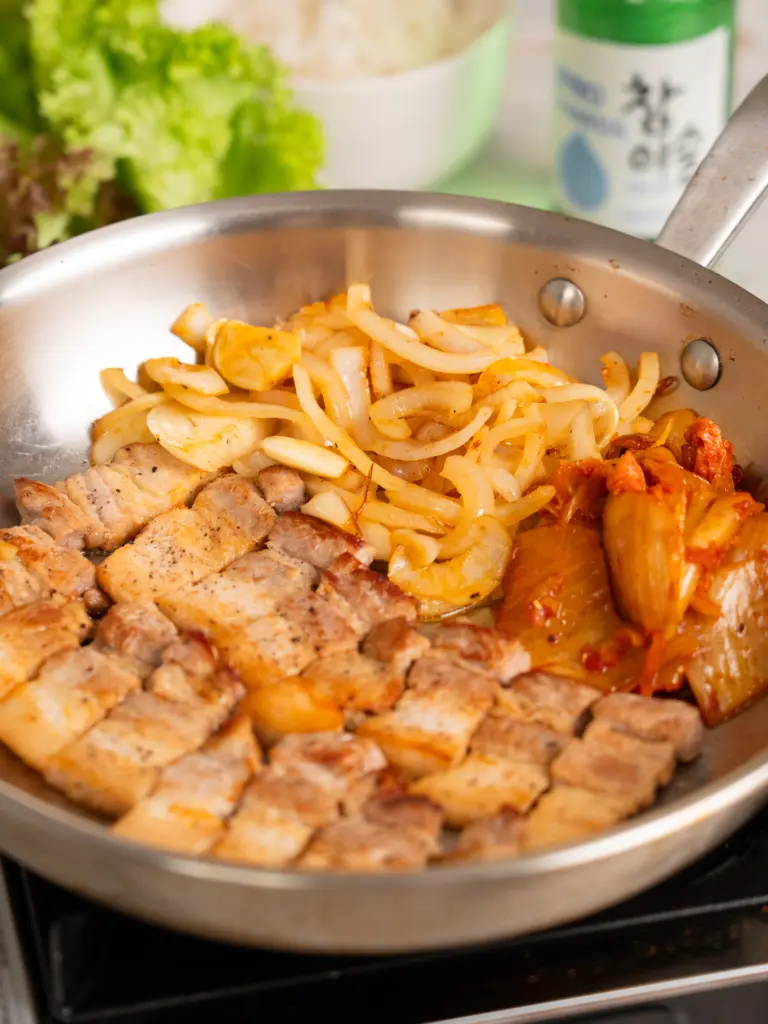
Did you make this recipe?
Please let me know how it turned out for you! Leave a comment below and tag @blondekimchi_ on Instagram and hashtag it #blondekimchi.
